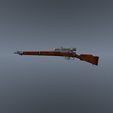Sniper rifles
Canadian sniper Sergeant Harold Marshall carries a No. 4 Mk. I (T) chambered in .303 British
L42A1 sniper rifle chambered in 7.62×51mm NATO
During both World Wars and the Korean War, a number of Lee–Enfield rifles were modified for use as sniper rifles. The Australian Army modified 1,612[53] Lithgow SMLE No. 1 Mk. III* rifles by adding a heavy target barrel, cheek-piece, and a World War I era Pattern 1918 telescope, creating the SMLE No. 1 Mk. III* (HT). (HT standing for "heavy barrel, telescopic sight),[13] which saw service in the Second World War, Korea, and Malaya and was used for sniper training through to the late 1970s.[54]
During the Second World War, standard No. 4 rifles, selected for their accuracy during factory tests, were modified by the addition of a wooden cheek rising-piece, and telescopic sight mounts designed to accept a No. 32 3.5× telescopic sight.[55] The telescopic sight had a field of view of 8 degrees 20 minutes and featured a bullet drop compensation range drum on top of the sight graduated in 50 yards (45.7 m) increments from 0 to 1,000 yards (914 m). Side adjustments in 2 MOA increments were made by the drum mounted at the side of the sight. These rifles were designated as the No. 4 Mk. I (T). The accuracy requirement was ability to place seven of seven shots in a 5 inches (12.7 cm) circle at 200 yards (183 m) and six of seven shots in a 10 inches (25.4 cm) circle at 400 yards (366 m). The wooden cheek-piece was attached with two screws. The rear "battle sight" was ground off to make room to attach the No. 32 telescope sight to the left side of the receiver. Each No. 32 and its bracket (mount) were matched and serial numbered to a specific rifle.[56]
In British service, the No. 32 telescope progressed through three marks with the Mk. I introduced in 1942, the Mk. II in 1943 which offered side adjustments in finer 1 MOA increments, and finally the Mk. III (Mk. 3) in 1944 which had an improved field of view of 8 degrees 30 minutes.[57] A transitional model the No. 32 Mk. 2/1 was also made. The Canadian scopes made by Research Enterprises Limited and were prefixed with a letter C and went through C No. 32 Mk. I, Mk. I A (a transitional model), Mk. II and Mk. 3. Many Mk. 3s and Mk. 2/1s (Mk. 2s Modified to Mk. 3 standard) were later modified for use with the 7.62×51mm NATO L42A1 sniper rifle. They were then known by the designation Telescope Straight, Sighting L1A1.
Initial production was 1,403 conversions of 1931–1933 troop trials No. 4 Mk. I rifles at RSAF Enfield and a few others including Stevens-Savage No. 4s. These were converted in late 1941 and into the later part of 1942. Then, the work was assigned to Holland & Holland, the famous British sporting gun manufacturers, which converted about 23,000 No. 4 Mk. I (T) and No. 4 Mk. I* (T) sniper rifles. The Holland & Holland conversions usually have the contractor code "S51" on the underside of the buttstock. BSA Shirley undertook 100 conversions to .22". James Purdey and Sons fitted special buttstocks later in the war. About 3,000 rifles, mostly Stevens-Savage, appear to have been partially converted by Holland & Holland but never received brackets, scopes of the final "T" mark. Canada converted about 1,588 rifles at Small Arms Limited (to the end of 1945) and, in 1946, at Canadian Arsenals Limited. Both were located at Long Branch, Ontario. Most of the Canadian made No.4 Mk.I* (T) sniper equipments went into British service. The No.4 (T) rifles were extensively employed in various conflicts until the late 1960s.
The British military switched over to the 7.62×51mm NATO round in the 1950s; starting in 1970, over 1,000 of the No. 4 Mk I (T) and No. 4 Mk. I* (T) sniper rifles were converted to this new calibre and designated L42A1.[46] The L42A1 sniper rifle continued as the British Army's standard sniper weapon being phased out by 1993, and replaced by Accuracy International's L96.[58]
I have set them to a 1:35/1:72 ratio for easy printing, and the size comes from the data provided by the encyclopedia. You can adjust its size to any place by yourself.
Note: If using the model for 3D printing, model repairs may be needed.

/https://fbi.cults3d.com/uploaders/27658003/illustration-file/7d29dece-3470-47d8-b4e1-750071ebe128/lee_enfield_no4_mk1_with_scope_-3840x2160.png)























